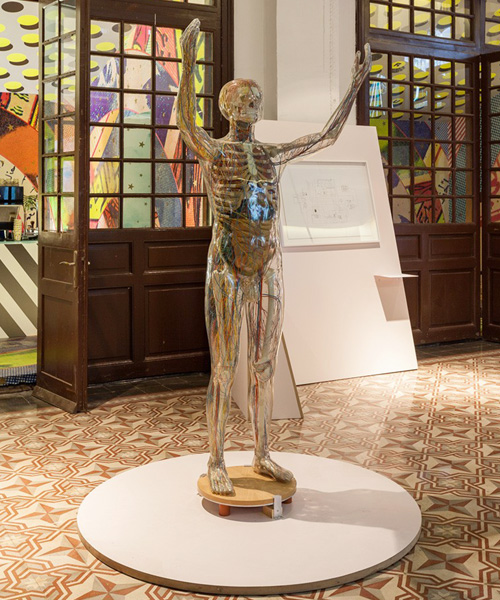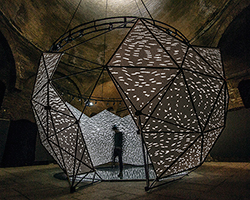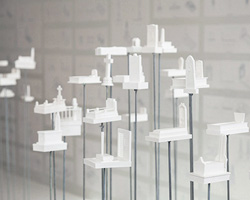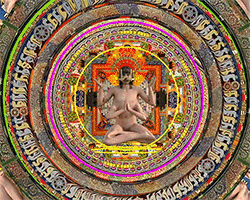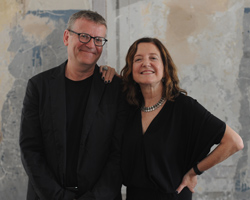istanbul design biennial: the transparent man by franz tschackert is on show as part of the exhibition ‘designing the body’, one of the core programs curated by beatriz colomina and mark wigley. the exhibit explores the different ways in which the human body is a highly unstable, continually reconstructed artifact — from the way our hands operate, to the latest findings on the brain. every dimension of the human is continuously adjusted, augmented or replaced.
what do the inside of our bodies look like?
historically, people have been curious about seeing what is inside objects, especially the human body. this perennial question has both fascinated and frightened humans, resulting in some of the most striking and influential images by doctors and artists — from manṣūr ibn muḥammad ibn aḥmad ibn yūsuf ibn ilyās, to dürer, and leonardo da vinci. from the 17th through the 19th century, the limitation of 2-dimensional drawings led to depictions of the human body in 3-dimensional models made of malleable materials, like gypsum, papier mache or wax. however, the solidity of these materials hindered the view of the interior and peering into ourselves became a design challenge.
‘the transparent man’ anatomy model revolutionized self-perception: it is a life-sized model of a man whose translucent skin exposes the inner intricacies of the body. the sculpture reveals the multi-layered spatial relationships between internal organs and skeletal, arterial venous, nervous and lymphatic systems. designed by german doctor and scientist franz tschackert, it was conceived at the deutsches hygiene museum in dresden as an educational device on anatomy and hygiene for the wider public. the first prototype was developed in 1927, but only went on public view as the centerpiece of the 2nd international hygiene exhibition in 1930.
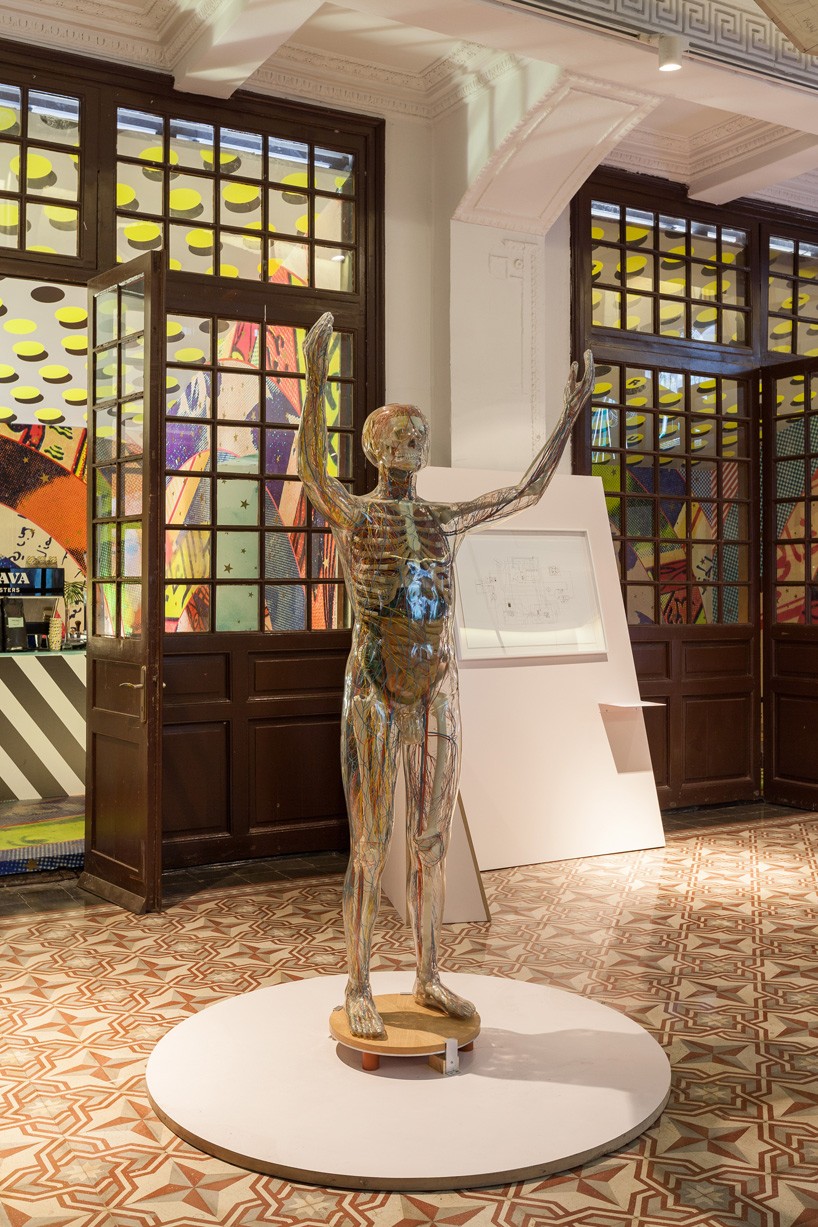
the transparent man (franz tschackert) in the istanbul biennial exhibition
collection of the deutsches hygiene-museum, dresden
image by sahir uğur eren
to begin with, tschakert managed to obtain a human skeleton that he endowed, with the help of some wires and supports, with an erect stature. next, the skeleton had to be given a human appearance. for that, it was stuffed with wood chips and covered with layers of gypsum until he had attained a human shape, entitled ‘gipsumjumbo’. it then served tschakert for production of a multi-part mould. each part was closed with a lid, then, between lid and form, tschakert inserted a sheet of celluloid that could be subjected to steam pressure via the lid and heated, softened and forced into the mould by the steam pressure. after subsequent water cooling, a moulding of the exterior shape could be withdrawn from the form. this could be cut, and the different parts glued together. the arms, legs, parts of the torso, etc. could then all be put together around the skeleton, in dismountable manner. the inner organs were derived from wax models in a nearby school where the director was a friend of tschakert’s. the organs were thus formed in the same manner as the exterior body, and afterwards they were painted according to their original colours. finally, the system of blood vessels was represented in red for arteries and blue for veins, and supplemented by the principal nerves, portrayed in green. [from: klaus vogel – the transparent man – some comments on the history of a symbol]
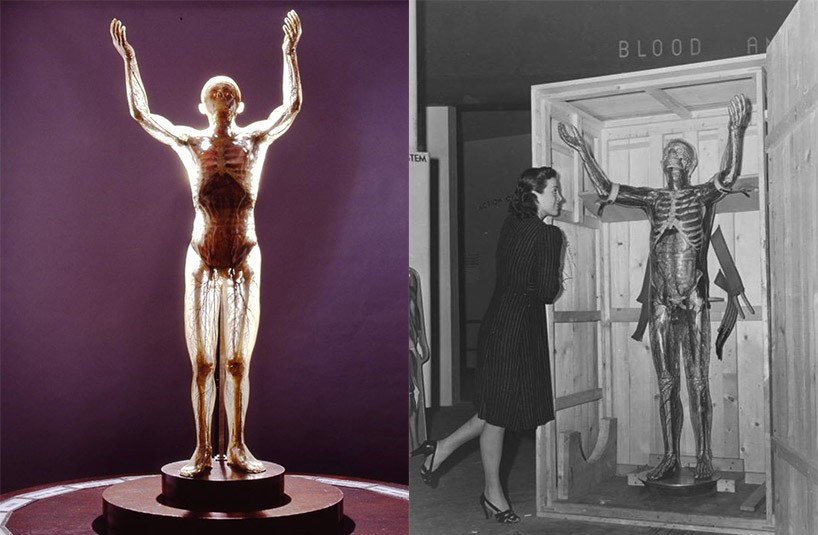
the transparent man lit from behind, 1934 / the ‘gläserne mensch’ model two in his crate at the 1939 NY world’s fair
the idea of modeling the impervious human body as a visually penetrable object came right after the development of the x-ray and psychoanalysis in the late 19th century. both of these bloodless technologies of ‘entering’ the body had a tremendous impact on the designers and architects. it is no coincidence that mies van der rohe had described his glass skyscraper for berlin as an architecture of skin-and-bones just a few years earlier in 1922. conversely, despite its plastic skin, the original name of transparent man in german was literally ‘glass man’ (gläserner mensch), assuming a whole new design conception of the body itself; a body whose once secrete interior is made public.
the figure firstly symbolizes, in utmost clarity, the claims of an unchallenged natural science that believes itself bound less and less by any secrets, and secondly, it belongs to the aesthetic school of the bauhaus. the elimination of all ornamentation, and a striving for clarity and transparency were principles which the directors of the bauhaus (originally in weimar, then from 1926 as the state college in dessau) carried through in their aesthetic program, from architecture, via fashion, to the construction of industrially manufactured everyday articles.
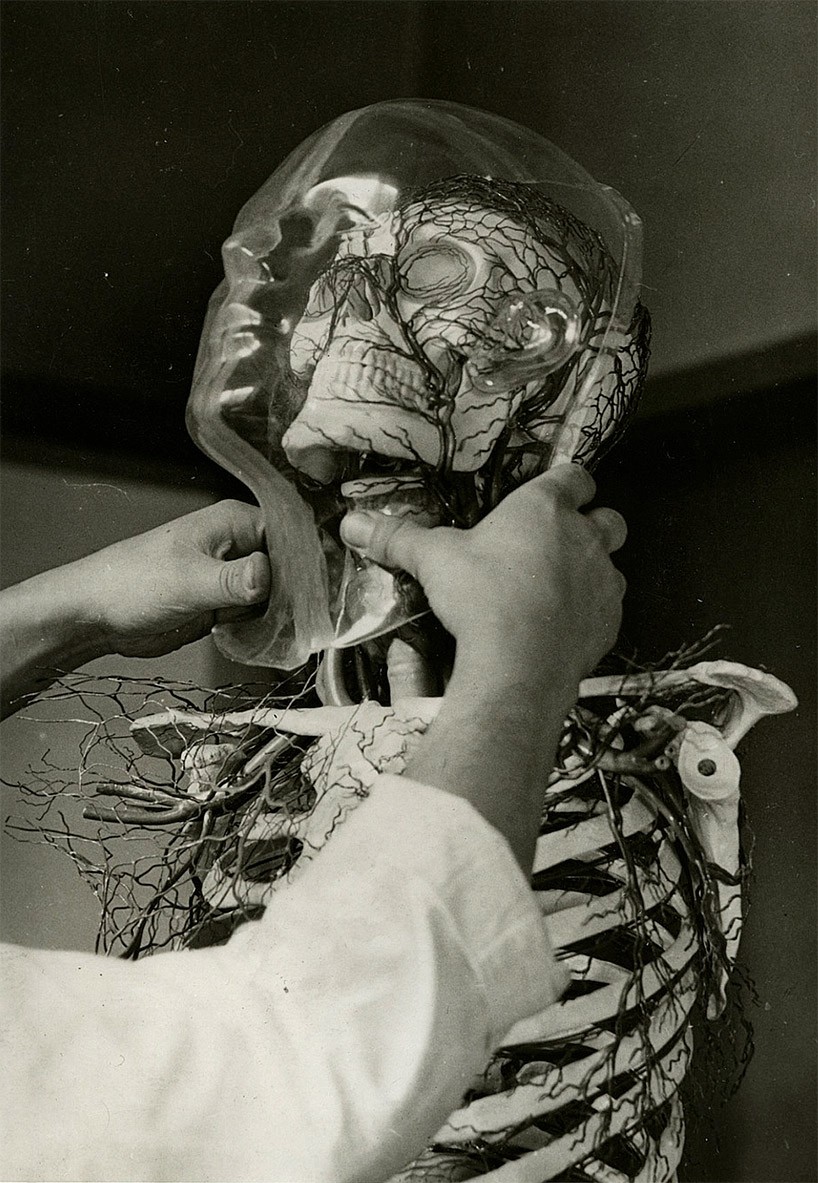
the first prototype was developed in 1927 and went on public view at the international hygiene exhibition in 1930
image courtesy deutsches historisches museum, berlin
the transparent man was an immediate sensation, becoming a hugely popular traveling exhibit with millions of visitors. it was often electrically illuminated to dramatize its transparency, and was accompanied by a spoken narrative played by a phonograph. its surveillance of the interior was closely associated with social surveillance. the campaign for hygiene also meant ‘racial hygiene’, and the model human was used from the beginning as a prop for the eugenic movement that started in england and was increasingly strong in germany and the US. it attracted hundreds of thousands of visitors st the eugenics-laden exhibition ‘the miracle of life’ in 1935, and the paris exposition of 1937. on the occasion of the latter, the turkish newspaper cumhuriyet reported that the ‘transparent man is a germsn artwork that is worthy of being considered among the seven wonders of the world, on which honors the 20th century. (…) upon insistence from the french ambassador in berlin, m.poncet, the transparent man’s transportation to france was permitted by a. hitler in person’.
transparent man actually visited turkey in 1938. it was first exhibited at the 10th exhibition of local goods at the galatasaray high school in istanbul, and at the 8th international izmir fair during the summer of the same year. right before the arrival of this ‘miracle of science’ in turkey, cumhuriyet enthused: ‘the inhabitants of istanbul and the people of the country will have the chance to witness a wonder of art that the whole world is curious about. (…) showing all the internal workings of a living man, the transparent man also makes a scientific description of the human body, speaking his own language. the germans approved the transparent man to speak in turkish; it was modified accordingly’.
the transparent man is a remarkable design artifact — with millions of imitation transparent plastic humans in school all over the world and in homes as educational toys. it also constitutes a minor yet important chapter in the history of modernization and scientization of interwar turkey. after WWII, the workshops at the deutsches hygiene-museum in dresden produced new exhibit models of transparent men and women faithfully based on tschacker’s original design. through one of them, the transparent man is paying a second visit to turkey for the 3rd istanbul design biennial, almost seven decades after its initial one in 1938.

the third istanbul design biennial is entitled ‘are we human?’, featuring more than 70 projects presented in four ‘clouds’ — designing the body, designing the planet, designing life, and designing time. the event explores the intimate relationship between humans and design over a time period that spans from the last two seconds to the last 200,000 years.
running from october 22 to november 20, 2016, the biennial presents more than 70 projects by over 250 participants, including designers, architects, artists, theorists, choreographers, filmmakers, historians and archaeologists from more than 50 countries. organized by the istanbul foundation for culture and arts (İKSV), the istanbul design biennial is hosted across five main venues; galata greek primary school, studio-X istanbul and depo in karaköy, alt art space in bomontiada, and istanbul archaeological museums in sultanahmet. this year’s edition has been curated by architectural historians and theorists beatriz colomina and mark wigley. colomina is professor of architecture and founding director of the program in media and modernity at princeton university, while wigley is professor and dean emeritus of columbia university’s graduate school of architecture, planning, and preservation.
ISTANBUL DESIGN BIENNIAL 2016 (5)
PRODUCT LIBRARY
a diverse digital database that acts as a valuable guide in gaining insight and information about a product directly from the manufacturer, and serves as a rich reference point in developing a project or scheme.
